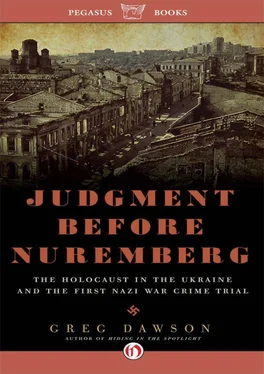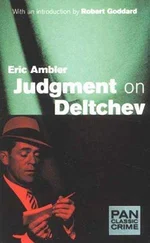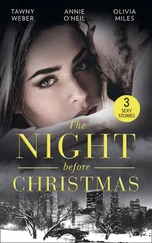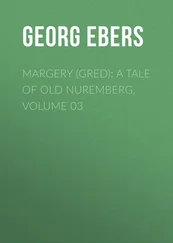The charade was dutifully maintained by Molotov in notes he sent to diplomats of friendly nations. In an April 1942 note, Molotov “detailed the murder of 3,000 civilians in Taganrog on October 27, 1941, of 7,000 inhabitants of the Crimean town of Kerch, of 6,000 people in Vitebsk, of 10,000 in Pinsk, of 12,000 in Minsk, and of 14,000 in Kharkov. Nowhere in the note does Molotov mention that the murdered victims were Jews.” [2] Arad, The Holocaust in the Soviet Union , 537.
The determined air-brushing of Jews from the picture reached Alice in Wonderland heights of absurdity in subsequent Soviet trials held in 1945–46 “where defendants and eyewitnesses revealed the horrors of ghettos, concentration camps, and mass executions, and where the charge of perpetrating the Holocaust—without its explicit mention—would frequently constitute the only basis for indictment,” Prusin wrote. [3] Prusin, “Fascist Criminals to the Gallows!”, Holocaust and Genocide Studies (2003), 21.
Stalin had complex reasons, personal and practical, for maintaining the fiction of a non-Jewish Holocaust in the Soviet Union. Stalin was fervently anti-Semitic, but it was bloodless pragmatism that led him to sell out the Jews after signing of the Ribbentrop–Molotov treaty in August 1939. All reports of Nazi persecution of Jews in German-occupied territories suddenly vanished from the Soviet press, which began strewing rose petals in the Führer’s path. Consequently, Jews never knew what hit them two years later when Hitler tore up the treaty, invaded, and sent the Einsatzgruppen after them. Hitler’s betrayal had the effect of distancing Stalin even further from the discrete plight of the Jews. The consistent theme of his wartime speeches was that Nazi Germany aimed to exterminate the Slavic and Russian people—a narrative that would be watered down by reference to Jews, the only group of Soviets in actual danger of extermination. Stalin also meant to blunt German propaganda that it was making war not against the Russian people but rather “Judeo-Bolshevism”—a notion that might appeal to anti-Semitism among Ukrainian soldiers and lessen their hatred for the invaders. Stalin’s erasure of the Jews was not simply a wartime expedience, as demonstrated by his post-war banning of The Black Book, a collection of eyewitness testimonies to Nazi crimes against Jews in Ukraine and other territories. Soviet censors stopped publication of The Black Book in 1947, and it did not see full light of day until 1980 when Yad Vashem published it in Russian.
Thus, it is hardly surprising—indeed, it is entirely consistent with the delusion fostered by Stalin—that in the first state-run trial of Germans there would be no mention of “Jews,” the primary victims whose slaughter was the very reason for the trial. Here is a key passage from the indictment read in court:
“In Kharkov, on Gestapo orders, many peaceful Soviet citizens were moved from their flats in the city to specially designated barracks on the territory of a workers’ settlement of the Kharkov tractor plant. The Soviet citizens on their way to the workers’ settlement were repeatedly plundered and subjected to humiliations. Having put the people in barracks, the Germans divided them into groups of two or three hundred people, including adolescents, children, and old folks, and then drove them to a gully four to five kilometers away from the tractor works where they were shot near large pits that had been prepared beforehand.”
This is a sanitized, Judenfrei version of the story my mother told me and which I recounted in Hiding in the Spotlight. In December 1941, her family and 16,000 other Jews were marched by Germans and Ukrainian collaborators from Kharkov to the tractor factory, where they were held for two weeks without food and water before being taken to Drobitsky Yar for execution. The singularly Jewish quality of this slaughter—contrary to the Soviet whitewashing at the trial—is found in numerous accounts by civilians and soldiers, both Russian and German. The small obelisk erected in 1955 at Drobitsky Yar with the inscription, “The victims of Fascist Terror 1941–1942 Lie here,” now stands as a monument to the madman’s denial of the Holocaust. Stalin lied here.
In September 1943, an eleven-member commission of Kharkov city officials, academics, an army general, a priest, and two representatives of the ESC issued a report titled “On the Mass Shooting of Jews by the German Murderers in the Drobitzki Valley.” During German occupation of Kharkov, “The Jewish population was totally destroyed one by one,” the report stated. “Upwards of 15,000 Jewish residents of the city were shot during the months of December 1941 and January 1942 alone near the so-called valley of Drobitzki. The barbarity inflicted on innocent victims was confirmed by evidence obtained from witnesses, from protocols by medical experts, and from other reliable documents.” By the time the report reached the courtroom in Kharkov, all references to “Jews” had been removed and replaced with various euphemisms such as “peace-loving citizens.”
The two-stage death march of Kharkov Jews—first to the tractor factory for temporary warehousing, then to Drobitsky Yar—is chronicled in Einsatzgruppe field reports sent back to Berlin, and by testimony of German soldiers in later inquiries by the West German government. In one deposition, a former member of a German police battalion said he was sent to a secluded area outside Kharkov sometime after Christmas 1941. “We were taken to hilly terrain where we had to form a huge seclusion ring that the civilian population was not allowed to enter. Into this the Jews from the ghetto were taken with trucks. The Jews had to undress and to lie down nearby or right inside crevices in the earth. The crevices were natural ones and not tank ditches or other dugouts. In these pits the Jews were shot by the S.D.”
Despite similar stagecraft, the Kharkov “show” was no rerun from the thirties. There was no need for fabricated evidence in the opera hall, wrote Prusin, because “traces of German crimes in the Soviet Union were visible, widely known, and undeniable.”
And they continued— even as the Kharkov trial proceeded. Kiev and Kharkov were now liberated cities, but in areas to the west the retreating Nazis were still burning villages and slaughtering civilians. At the same time, the most gruesome cover-up in history was underway across Ukraine—the exhuming and incinerating of more than a million bodies, most of them Jewish, under the supervision of tormented Col. Blobel. It seemed an odd task for a man who quaked at the sight of fifty bodies in a gangswagen, much less tens of thousands of corpses festering in their own blood and vomit.
By December 1943, the tide was turning dramatically against Germany—Berlin and other cities had been under heavy Allied bombardment since mid-November—but the end of the war was still eighteen months away. The Kharkov trial came as a surprise to Churchill and Roosevelt, co-signers with Stalin of the Moscow Declaration just six weeks earlier. The Declaration stipulated that any accused Germans be returned to the scene of their crimes for trial and punishment, and in language unusually vivid for official statements it noted that “in their desperation the recoiling Hitlerites and Huns are redoubling their ruthless cruelties. This is now evidenced with particular clearness by monstrous crimes on the territory of the Soviet Union which is being liberated from Hitlerites, and on French and Italian territory.” Still, no one expected the Soviets to act on the Declaration before the ink was dry.
“After the Moscow meeting many persons regarded the decision about war criminals as something for the future, something to be attended to after the fighting was over,” Edwin James wrote in the New York Times on the third day of the Kharkov trial. “Many recalled the now famous 1919 cry of ‘Hang the Kaiser’ and recalled that it came to nothing, and classified the Moscow ruling as something for later on. Not so Stalin.”
Читать дальше












